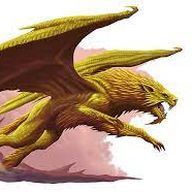Dragonnes usually attack fint with their front
claws and their terrible jaws. This is usually enough to
slay most of the creatures the dragonne encounters. If a
dragonne is in combat with an espedany deadly opponent,
or is wounded in a battle with a lesser opponent, however,
it will use its deadly roar.
A dragonne‘s roar causes fear in all creatures within
120 feet of the monster. Worse still, any creature within
30 feet of the dragonne when it roars are deafened for
a minute. The dragonne’s roar can only be used three
times a day.
Although a dragonne‘s wings are useful only for short
periods of time, carrying the creature for only a few
minutes at a time, the dragonne uses its wings very
effectively in battle. If any creatures attempt to charge the
dragonne or encircle it, the dragonne simply takes to the
air and finds a more defensible position. It can fight with
its claws and bite, and even its roar, when airborne, so
it remains almost as deadly in the air as on the ground,
though it prefers not to.
Possessing some of the most dangerous qualities of a lion and a brass dragon, the dragonne is a vicious and deadly hunter, and a threat to many who travel in wanner climates. From a distance, a dragonne looks much like a giant lion, with the one very notable exception of the pair of small, brasscolored wings that stretch from the creature’s shoulders. Upon closer inspection, other differences between the dragonne and its feline ancestor become apparent, too. The dragonne is covered with thick, brasscolored scales, much like a brass dragon, and its mane is much thicker and made of far coarser hair than a lion’s, The beast also possesses huge claws and fangs, and large eyes, usually brasrcolored like its scales. Dragonnes do not have their own language. Instead, they speak the languages of brass dragons and sphinxes.

